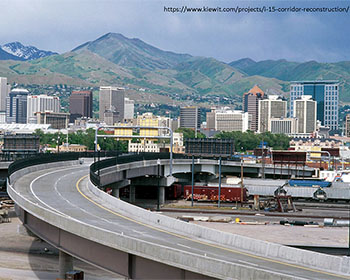

MPC |
| Title: | Calibrating Ground Response Analyses beneath an Instrumented Bridge Using the I-15 Borehole Array and Ground Motions from the Magna Earthquake |
| Principal Investigators: | Brady Cox |
| University: | Utah State University |
| Status: | Completed |
| Year: | 2022 |
| Grant #: | 69A3551747108 (FAST Act) |
| Project #: | MPC-694 |
| RH Display ID: | 159655 |
| Keywords: | boreholes, bridges, calibration, earthquakes, instrumentation, seismicity |
 On March 18, 2020, a magnitude 5.7 earthquake struck the Salt Lake Valley near Magna, Utah. Important ground motions were recorded by a geotechnical borehole array installed near the intersection of I-15, I-80 and SR-201 in Salt Lake City. Borehole arrays play a key role in understanding seismic site response and in calibrating numerical ground response analyses (GRAs). This particular borehole array is even more valuable, as it lies in close proximity to a flyover bridge that is instrumented with 18 accelerometers that recorded structural response during the Magna earthquake. There is a need to study the ground motions recorded by the I-15 borehole array as a means to calibrate seismic GRAs that can inform numerical modeling at bridge sites throughout the Salt Lake Valley where shaking was not recorded. The overarching research objective of this proposal is to perform numerical 2D and 3D GRAs for the I-15 borehole array site using a large, site-specific 3D shear wave velocity model that will be developed from non-invasive methods. The GRAs will then be calibrated at small- to moderate-strains using the ground motions recorded by the borehole array throughout its lifetime and during the 2020 M5.7 Magna earthquake and its aftershocks.
On March 18, 2020, a magnitude 5.7 earthquake struck the Salt Lake Valley near Magna, Utah. Important ground motions were recorded by a geotechnical borehole array installed near the intersection of I-15, I-80 and SR-201 in Salt Lake City. Borehole arrays play a key role in understanding seismic site response and in calibrating numerical ground response analyses (GRAs). This particular borehole array is even more valuable, as it lies in close proximity to a flyover bridge that is instrumented with 18 accelerometers that recorded structural response during the Magna earthquake. There is a need to study the ground motions recorded by the I-15 borehole array as a means to calibrate seismic GRAs that can inform numerical modeling at bridge sites throughout the Salt Lake Valley where shaking was not recorded. The overarching research objective of this proposal is to perform numerical 2D and 3D GRAs for the I-15 borehole array site using a large, site-specific 3D shear wave velocity model that will be developed from non-invasive methods. The GRAs will then be calibrated at small- to moderate-strains using the ground motions recorded by the borehole array throughout its lifetime and during the 2020 M5.7 Magna earthquake and its aftershocks.
Note to project PIs: please use the Track Changes feature when editing the above Word file(s). Updated document(s) should be emailed to ndsu.ugpti@ndsu.edu.